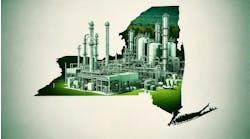An energy audit is fundamental for plants that wish to control energy costs. The audit has two essential parts: 1) the analysis of purchased energy and how it's converted into other usable forms; and 2) an energy use and utilization analysis. The results can help identify areas that waste energy and how best to recover and reuse that energy. An audit also can help continuously monitor a plant's conditions over the years.
[pullquote]
The first part of the energy audit is to understand the energy inputs into the plant. Although we typically don't "see" energy, we do see the energy bills. Hence, the first step of an energy audit tries to allocate purchased energy cost as it's used in plant operations.
Plants purchase energy in the form of fuel and electricity and use some of it for several energy commodities that operations depend upon. For example, fuel is used to generate steam to the desired pressure level to heat the contents of a reactor to produce desired product. Electricity is used to pump product from a reactor to a crystallizer and then to separate the crystals. Electricity also is used to compress air to move product. Hence, properly accounting for, and allocating energy costs, to each energy commodity is essential.
It's also necessary to be as detailed as possible when classifying energy commodities. Air is free when it enters an air compressor, but the same air isn't free when it leaks from the pipeline. Steam is nothing but water when it's pumped into a boiler water treatment plant. It's not the same water when it is drained out after a steam trap. Allocating the energy costs to steam and heat in a generalized manner has limited use in the energy audit. Consider these energy costs (where applicable) for a fruitful energy audit:
1. Cost of heat when derived from natural gas and biomass fuel.
2. High-pressure steam cost at the boiler with natural gas and biomass fuel.
3. Medium-pressure steam cost when passed through a pressure relieve valve (PRV).
4. Low-pressure (LP) steam cost when passed through a steam turbine.
5. LP steam cost when condensate is and isn't returned.
6. Cost of condensate when returned at 190°F and 130°F.
7. Cost of compressed air distributed to process plants.
Properly allocating the cost of purchased energy into energy commodities also will help in the next step: analyzing energy conversion and utilization costs.
Generally, preparing an energy balance would help identify the efficiency of energy utilization. Energy balance in a boiler would provide the energy conversion efficiency, while the energy balance in a product dryer would provide the energy utilization efficiency.
An energy audit also evaluates key indicators, such as the specific energy consumption of the product. For example, MMBtu/lb of ammonia, and kWh/lb of chlorine are common indicators in fertilizer and chlor-alkali plants.
Once you evaluate conversion or utilization efficiency, or specific energy consumption, you should compare these key indicators with the best in the process to get the improvement potential. This, when combined with energy costs and marginal energy costs, provides the energy cost reduction potential. For example, adding an economizer and trimming down the blowdown water contributes to higher boiler efficiency. However, an energy audit would recommend lowering the steam cost to a plant that doesn't have these features in its boiler. In the same manner, if the cost of steam used in a process unit is properly allocated, the energy audit would recommend reducing the steam cost in that unit by operating the steam turbine instead of a PRV and returning the condensate back to the boiler.
Finally, convincing plant engineers and managers to move toward measuring, monitoring and improving their energy efficiency is the true success of a fruitful energy audit. Well-received energy audit reports typically include:
1. A prioritized list of energy-savings measures that could reduce the wasted energy based on potential savings and preliminary investment numbers.
2. A breakdown of energy use, costs of energy commodities and key energy indicators.
3. Identification of design, operation and maintenance practices that lower efficiency.
4. An action plan to move forward implementing low-cost or no-cost measures.
VEN V. VENKATESAN is Chemical Processing's Energy Columnist. You can e-mail him at [email protected]


